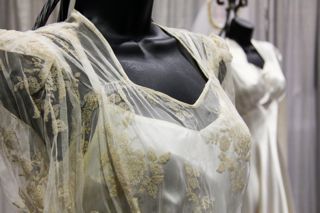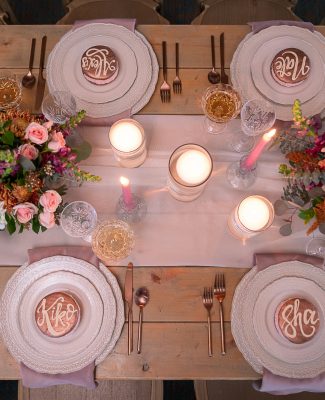Get the Facts – Wedding Dress Cleaning
Author: Katherine Wright

The first step in the proper care of your wedding gown is to have it cleaned. But who do you trust with your treasured gown? Your local dry-cleaner? A national company? A little bit of knowledge will help you to make an informed decision.
You should be aware that many local dry-cleaners do not clean and preserve gowns in their facilities, but choose to send their customer’s bridal gowns out to wholesale dry-cleaners. Wholesale dry-cleaners clean wedding gowns in large volume, perhaps thirty gowns at a time or more. This may result in less attention to individual gowns.
When choosing a dry-cleaner, you will need to know which solvents your local cleaner uses, or if he sends bridal gowns out, which solvent the wholesale dry-cleaner uses.
Find a dry-cleaner who uses new or distilled solvent for cleaning wedding gowns. Because of ecological regulations and expense, solvents are recycled. Impurities that are not filtered out of used solvent can be re-deposited onto garments. Garments cleaned in dirty solvent will have a dry clean smell.
A good dry-cleaner will use virgin solvent on all wedding dresses. A clean wedding gown should not smell like cleaning solvent. There should be no noticeable odor.
Wet-cleaning
Some dry-cleaning shops use what is called wet-cleaning for their bridal gowns. Wet cleaning is simply cleaning with water and has several advantages.
- It is the best cleaner for sugar spills, perspiration and most food stains.
- If the dress has been well rinsed, wet-cleaning leaves no chemicals on the dress, which will help to keep the dress in the best possible condition.
- Water washing removes the fabric sizing (a starch like substance added to fabric during manufacturing.) Removing the sizing helps protect your gown, because sizing is enticing to mice and insects!
Some professional cleaners may use either dry-cleaning or wet-cleaning, depending on the gown fabric. Many bridal gown care labels specify which type of cleaning will be best for that particular gown. However, many manufacturers use generic “Dry-clean only” labels for all of their wedding gowns, when in fact, wet cleaning may be perfectly fine. Look for the water symbol on the care tag. This indicates that the manufacturer believes wet cleaning is safe for that gown.
Dry-cleaning
Four dry-cleaning solvents commonly used for cleaning bridal gowns are: Perchloroethylene, Stoddard solvent, Hydrocarbon (I.E. Exxon DF-2000), and Greenearth.
- Perchloroethylene
Commonly called perc. this is the most common solvent that dry-cleaners use. It is the best solvent for degreasing and may be your best choice if your dress is silk, rayon, or acetate and quite dirty. However, this solvent is more likely to damage sequins and beads, or melt the glue if they are glued on. A very experienced dry-cleaner will know how to protect the sequins and beads on your dress. - Stoddard solvent.
Harder to find, this is a petroleum-based solvent that is becoming rare. Because of fire regulations, this solvent cannot be used in strip mall type dry-cleaning establishments, and is therefore not commonly used. You may find this solvent in older dry-cleaning shops that have been around for a while. It is safer for cleaning dresses with sequins and beads than perchloroethylene. The Stoddard solvent shouldn’t melt beads and sequins or affect the glue if they are glued on. - Hydrocarbon (I.E. Exxon DF-2000)
This is a newly formulated petroleum-based solvent. Like the Stoddard solvent, it is safer for beads and sequins, but is not quite as effective at degreasing as perchloroethylene and the Stoddard solvent. However, it has fewer fire restrictions than the Stoddard formula and may be the formula of the future as many dry-cleaning shops change over to this new solvent. - Silicone (Greenearth)
Silicone solvent is not as aggressive as Perchloroethylene. But like Hydrocarbon, it is safe for beads and sequins. It is also the most environmentally friendly of all available solvents besides water.
Petroleum-based solvent
Some bridal gown care labels state, Dry clean only with petroleum based solvent. Both the Stoddard solvent and Hydrocarbon are petroleum based. But finding a dry-cleaner who uses one of these can be difficult. However, many dry-cleaners are switching to Hydrocarbon, so you may be able to find one with a few phone calls.
Generally gowns requiring petroleum solvent have beads or sequins that need protection. Be aware that Greenearth solvent is also safe for beads and sequins.
Dry-cleaner’s experience
Experience is probably the most important factor to consider in selecting a dry-cleaner if your gown is silk. Silk is more difficult to clean and press than synthetic fabrics and requires a truly skilled cleaner. Check with your local bridal shops to see whom they use and recommend. Ask more than one bridal shop. Bridal shops have wedding gowns cleaned on a regular basis. They will probably give you the best advice. Ask the questions listed below to the dry-cleaner that the bridal shop recommends.
Cleaning Summary
If your gown and/or lining is silk, rayon, or acetate but does not have beads or sequins you should be able use a dry-cleaner that uses perc. That will be a plus if the dress is really dirty (look at the hemline!) Perchloroethylene is the best degreaser. If your dress is silk, rayon, or acetate, but has beads and sequins, the Hydrocarbon, Stoddard formula or Greenearth (silicone) will be the safest.
Be sure to point out any stains to the dry-cleaner. Also, notify the dry-cleaner of any spills on the dress, even if they don’t show. Dry-cleaning fluids will not remove sugar stains (such as wine or soda), so the dress needs to be pre-treated.
If your dress and lining are polyester, with or without beads and sequins, wet cleaning should be safe and will get your dress the cleanest. Check your label carefully, and look for a Dry-clean or Hand wash label, or the symbol indicating water washing. If in doubt, test clean an inconspicuous area of the dress. You should be able to safely hand wash most polyester gowns if you are careful. *
Article Source: http://www.articlesbase.com/weddings-articles/get-the-facts-wedding-dress-cleaning-636841.html
About the Author
Katherine Wright is a wedding gown cleaning and preservation specialist and general partner of Heritage Garment Preservation located in Benicia, California providing Museum Method wedding gown preservation to the United States, Canada, and Europe.























